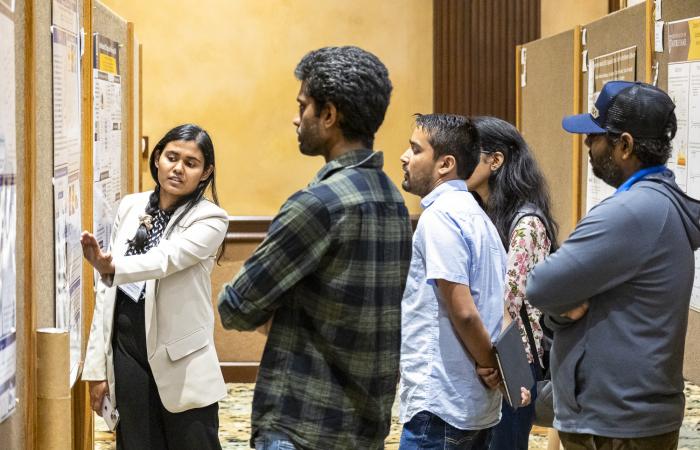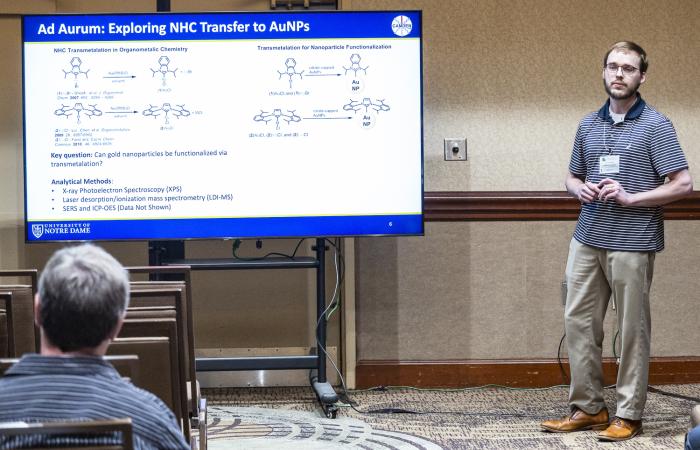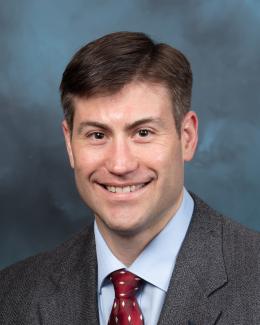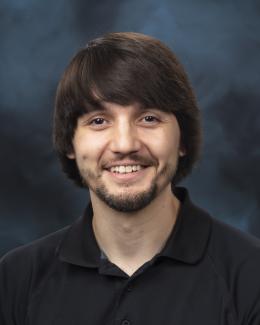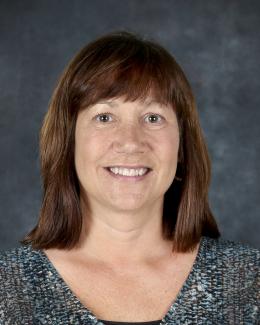Speakers, scientific workshops, speed networking, a student poster showcase and more energized the Annual User Meeting of the Center for Nanophase Materials Sciences, or CNMS, Aug. 7-10, near Market Square in downtown Knoxville, Tennessee.
The CNMS is located at the Department of Energy's Oak Ridge National Laboratory.
Organized by the CNMS User Executive Committee, or UEC, and the CNMS User Program Office, the meeting brings together leading researchers, junior scientists, postdoctoral researchers and students to highlight research areas and exchange ideas. This year’s gathering drew more than 200 attendees.
A main feature was the speed networking event. Nine groups composed of staff members from different CNMS research areas each sat at a different table. Users received a number, one through nine, to point them to their starting table, and they switched to a new table for a new interaction every 8 minutes.
“Mimicking the speed dating approach, this event fostered vibrant conversations, facilitated the exchange of ideas and encouraged networking among attendees,” said UEC chairperson Zach Hood.
“Normally, a user is likely to work primarily with one group and be unaware of the capabilities of the other eight groups,” said Brad Lokitz, CNMS User Program director and senior technical staff member of The Macromolecular Nanomaterials group. “Here we created a fun dynamic for engagement, and we heard that a lot of people really enjoyed this activity and made some new connections and experimental plans they hadn’t thought about before.”
During a panel discussion on “Promoting Diversity and Overcoming Implicit Bias in Scientific User Facilities and User Groups,” experts delved into critical topics around implicit bias, which refers to the attitudes or stereotypes that influence our actions, decisions and judgments toward individuals or groups, often without our awareness. Hood said he believes exploring the topic prompts introspection and growth within the scientific user community.
The student “poster slam” added a stimulating element to the meeting by enabling students to showcase their research in succinct 1-minute presentations to highlight their posters.
“This format not only refined their communication skills but also captivated the audience through a swift exploration of diverse research topics,” Hood said.
An open call led to the submission of 50 posters to be showcased at the meeting, and 34 of the submitters requested to participate in the poster slam competition, which was judged by a panel of UEC members. The judges walked through the poster display area discussing the works with the authors.
The judges determined the recipients of the Best Student Presentation Award based on organization and structure; graphs, charts, images and technical accuracy; and originality, effort and overall presentation.
The winners of the Best Student Presentation were Adam Dodson of Vanderbilt University for “Temperature Dependence of the Dominant Visible Transitions of Er3+ in Single-Crystal Er2O3,” Bogdan Dryzhakov of the University of Tennessee, Knoxville, for “Heterostructured Ferroelectricity with Light-Emitting Properties by Intracrystalline Mixing of 2D- and 3D-Perovskite Phases,” Lynnicia Massenburg of The Pennsylvania State University for “Structural Organization of Physcomitrium patens Cellulose Synthase 5 Homotrimeric Assemblies,” Vincenzo Musico of North Carolina State University for “Lattice Flexibility During Ion Insertion in Tungsten Oxides,” and Kyra Owensby of the University of Tennessee, Knoxville, for “Lithium Morphology Evolution Through Crosslinked Poly(ethylene Oxide) Solid Polymer Electrolyte.” The winners received a $75 gift card from Oak Ridge National Laboratory along with a certificate.
Another honor announced during the meeting was the Outstanding CNMS Staff Member Award, for which the UEC chose Michael Zachman. The following is one of several favorable comments the voters made about him: “Michael is a highly meticulous scientist that goes the extra mile to support users in acquiring and interpreting STEM data. His dedication to providing exceptional assistance brings about a remarkable and comprehensive user experience.”
Numerous invited talks provided attendees with a comprehensive overview of leading-edge research and developments across multiple disciplines in nanoscale materials sciences. Professors David Masiello from the University of Washington and Oana Jurchescu from Wake Forest University offered fresh perspectives on scientifically diverse topics in nanoscience to inspire innovative thinking.
As the meeting neared its conclusion, the attendees participated in a town hall discussion in which users asked questions of the UEC and CNMS staff and leadership and expressed any concerns. This portion of the event is an avenue for users to inquire about instrumentations, the future directions of the center and other topics.
After the town hall, about 40 of the attendees boarded a bus from the hotel to go for a tour of the CNMS. Divided into groups, the users were shown four labs: the Functional Atomic Force Microscopy group’s lab and its advanced force microscopy and scanning probe microscopy tools; the Nanofabrication Research group’s lab, including the 10,000-square-foot clean room and all of its equipment and tools; the Functional Hybrid Nanomaterial group’s quantum synthesis labs with autonomous characterization; and the Macromolecular Nanomaterials group’s autonomous synthesis for polymers and chemistry-related activities lab and the 3D printer lab.
The tour then shifted to the main campus to see some of the CNMS’s microscopes: the atom probe tomography instrument, the new KRIOS cryo transmission electron microscope, and the monochromated aberration-corrected scanning transmission electron microscope, or MACS TEM.
During the tour, users had a chance to learn from CNMS experts about some of the center’s instruments, techniques and collaborative opportunities.
“We’re all about the users,” Lokitz said. “CNMS is a synergistic science and user facility. In-house research frequently overlaps with user research, and users will often come to the CNMS to collaborate with our staff because of their expertise and leadership in nanoscience.”
“The 2023 CNMS User Meeting is being praised by the user community and CNMS staff as one of the best user meetings in over a decade, thanks to the great organization by the CNMS UEC and the CNMS User Program Office, and importantly, to an exciting program with compelling speakers, scientific workshops, and a high degree of participation in numerous events,” said Karren More, CNMS director. “This is an excellent model that will provide a template for future user meetings.”
ORNL’s CNMS, a Department of Energy Office of Science user facility, offers the national and international user community access to staff expertise and state-of-the-art equipment for a broad range of nanoscience research, including nanomaterials synthesis, nanofabrication, imaging, microscopy, characterization and theory-modeling simulation.
UT-Battelle manages ORNL for DOE’s Office of Science, the single largest supporter of basic research in the physical sciences in the United States. The Office of Science is working to address some of the most pressing challenges of our time. For more information, please visit energy.gov/science.


